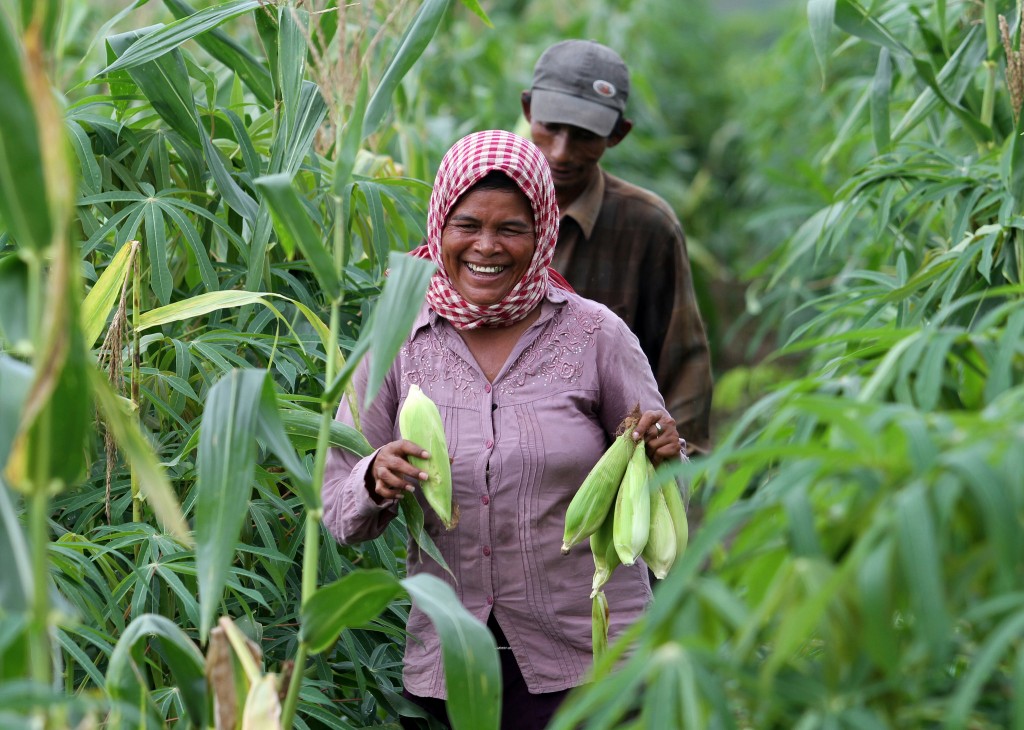
កសិករប្រមូលផលពោតពីកសិដ្ឋានរបស់ពួកគេ នៅកម្ពុជា។ រូបភាព ថតដោយ ធនាគារពិភពលោក/ឆ សុគន្ធា, ១៧ កក្កដា ២០១៣។ អាជ្ញាប័ណ្ណ CC BY-NC-ND 2.0
ទំនិញ និងផលិតផលកសិកម្មសំខាន់ៗ មានស្រូវអង្ករ កៅស៊ូ ពោត បន្លែ ផ្លែឈើ និងដំឡូងមី។ នៅឆ្នាំ ២០១៥ ជាង៩០ភាគរយនៃការនាំចេញកសិផលនៃប្រទេកម្ពុជា ត្រូវបានរំពឹងទុកថា ជាផលិតផលមិន ទាន់កែច្នៃ។1
កំណើនផលិតកម្មកសិកម្មនៃប្រទេសកម្ពុជា ប្រចាំឆ្នាំ រីកធំធាត់ប្រមាណជា ៨.៧% ចាប់ពីឆ្នាំ ២០០៤-ឆ្នាំ២០១២ ដែលជាអត្រាកំណើនខ្ពស់បំផុតមួយ នៅក្នុងពិភពលោក។2 កំណើននេះ ភាគច្រើន កើតចេញពីការហក់ឡើងទៅលើទិន្នផលផលិតកម្មដំណាំស្រូវអង្ករ (កំណើនប្រចាំឆ្នាំមាន ៩%) ពោត (២០%) ដំឡូងមី (៥១%) អំពៅ (២២%) និងបន្លែ (១០%)។3
យ៉ាងនេះក្តី នៅឆ្នាំ២០១៣-២០១៤ កំណើនផ្នែកកសិកម្ម បានថយចុះមកនៅត្រឹមតែ ១%។4 ការនាំចេញអង្ករនៃប្រទេសកម្ពុជា ប្រមាណជា ៣៨៧,១០០ តោន គឺជាកំណើនប្រមាណជា ២% បើធៀបទៅនឹងការនាំចេញអង្ករនៅឆ្នាំ២០១៣ ដែលមានប្រមាណជា ៣៧៨,៨៥០ តោន។ តម្លៃអង្ករ បានធ្លាក់ចុះប្រមាណជា ៣០%។5 គោលដៅនាំអង្ករចេញឲ្យបាន១លានតោននៅឆ្នាំ២០១៥ មិនបាន សម្រេច (គោលដៅនេះ បានកំណត់តាំងពីឆ្នាំ២០១០មកម្លេះ)។ តម្លៃសម្រាប់ផលិតផលផ្សេងទៀត ដូចជា កៅស៊ូ និងពោត ក៏បានធ្លាក់ចុះផងដែរ។
គុណភាពខ្ពស់, ការប្រឈមធំ
ផលិតផលកម្ពុជាជាច្រើន ទទួលកេរ្តិ៍ឈ្មោះលើឆាកអន្ដរជាតិសម្រាប់គុណភាពល្អ។ សម្រាប់រយៈពេល ៣ឆ្នាំ បន្តបន្ទាប់គ្នា នៅឆ្នាំ២០១២, ឆ្នាំ២០១៣ និងឆ្នាំ២០១៤ អង្ករម្លិះនៃប្រទេសកម្ពុជា ឈ្នះពានរង្វាន់ពិភពលោកជាអង្ករល្អដាច់គេ។6 ម្រេចកំពត ទទួលបាន ម៉ាកសម្គាល់ទីតាំងភូមិសាស្ត្រ ដែលជាកិច្ចផ្តួចផ្តើមរបស់អង្គការពាណិជ្ជកម្មពិភពលោក ក្នុងការតភ្ជាប់គុណភាពផលិតផល ទៅនឹងទីតាំងភូមិសាស្ត្រដើមរបស់ខ្លួន។
យ៉ាងនេះក្តី នៅមានឧបសគ្គជាច្រើនដែលត្រូវជំនះឲ្យបាន ដើម្បីអភិវឌ្ឍវិស័យកសិកម្ម ការកសាងឧស្សាហកម្មកែច្នៃ និងការធានាឲ្យបាននូវកំណើនលើការនាំចេញក្នុងទ្រង់ទ្រាយធំ។ បញ្ហាទាំងនោះ រួមមាន៖
- កង្វះខាតគ្រឿងបរិក្ខារកែរច្នៃសម្រាប់ផលិតជាច្រើន ដូចជា អង្ករ កៅស៊ូ និងស្វាយចន្ទី។
- កង្វះគ្រឿងបរិក្ខាររក្សាទុកសម្រាប់កសិផល ដូចជា អង្ករ ពោត កៅស៊ូ ដែលជាហេតុធ្វើឲ្យ កសិករត្រូវលក់ទិន្នផលទាំងនោះ នៅពេលប្រមូលផលបាន ដោយមិនគិតអំពីតម្លៃទីផ្សារ ពីព្រោះវាមិនអាចរក្សាទុកចាំរហូតតម្លៃឡើងថ្លៃទេ។ កង្វះខាតអគ្គិសនីនៅតាមតំបន់មួយចំនួន និងតម្លៃថាមពលថ្លៃ បើធៀបនឹងប្រទេសដទៃក្នុងតំបន់។ បញ្ហានេះ បានបង្ករជាការលំបាកដល់ការអភិវឌ្ឍឧស្សាហកម្មកែរច្នៃ និងធ្វើឲ្យតម្លៃប្រតិបត្តិការកាន់តែខ្ពស់។
- តម្លៃទំនិញ និងអាហារសកលលោក បានធ្លាក់ចុះ និងមិនមានសញ្ញាថានឹងហក់ឡើងទេ។
- អ្នកផលិតខ្លះ និយាយអពីបញ្ហាដឹកជញ្ជូន និងហេដ្ឋារចនាសម្ព័ន្ធ ដូចជាការលំបាកក្នុងការដឹកជញ្ជូនអង្ករក្នុងបរិមាណច្រើនតាមកំពង់ផែរ។7
- ថវិកានៅរឹតត្បិតខ្លាំង សម្រាប់កិច្ចការផ្សព្វផ្សាយផលិតផលកម្ពុជានៅឯនាយសមុទ្រ។
- កសិផលខ្លះ ត្រូវបាននាំចេញត្រឹមតែនៅប្រទេសជិតខាងប៉ុណ្ណោះ ហើយតម្រូវការ និង តម្លៃ អាច អស្ថិរភាព។
គោលនយោបាយរដ្ឋាភិបាល
ការអភវិឌ្ឍវិស័យកសិកម្ម ជាពិសេសកំណើនការកែច្នៃ គឺជាធាតុមួយដ៏សំខាន់នៃគោលនយោបាយអភិវឌ្ឍន៍ឧស្សាហកម្មកម្ពុជា ឆ្នាំ២០១៥-២០២៥ ដែលត្រូវបានបង្ហាញជាសាធារណៈកាលពីខែ សីហា ឆ្នាំ២០១៥។8 គោលដៅសំខាន់មួយនៅក្នុងគោលនយោបាយនេះ គឺបង្កើនការនាំចេញផលិតផលកសិកម្មកែច្នៃ ឲ្យបាន ១២ភាគរយ ដែលស្មើនឹងកំណើន ៤ភាគរយ ធៀបនឹងតួលេខកាលពីឆ្នាំ២០១៥។
ទំនិញ និងផលិតផល
ចំណូលបានមកពីការធ្វើស្រែចំការ អាចខុសគ្នាអាស្រ័យទៅនឹងប្រភេទដំណាំដែលកសិករជ្រើសយកមកធ្វើ ហើយការសិក្សាស្រាវជ្រាវរបស់ធនាគារពិភពលោក បង្ហាញថា ភាពខុសគ្នាបន្តិចបន្តួចនេះ អាចននាំឲ្យ មានការផ្លាស់ប្តូរប្រទេសកម្ពុជា។9 ការបែងចែកដីធ្លីសម្រាប់ដំណាំស្រូវ បានថយចុះពី ៨៦ភាគរយ មកនៅត្រឹម ៧៤ភាគរយ ពីឆ្នាំ២០០២ ទៅឆ្នាំ២០១១ ខណៈដែលចំណែកដីធ្លីសម្រាប់ផលិតកម្មពោត និងដំឡូងមី បានកើនឡើងគួរជាទីកត់សម្គាល់។ នៅឆ្នាំ២០១៣ អត្រាចំណូលខាងកសិកម្មជាមធ្យម (និងផលិតកម្មការងារ) មានប្រមាណជា ៥០៦ដុល្លារ/ហិកតា (៩.៤ដុល្លារ/ថ្ងៃ) សម្រាប់ដំឡូងមី ៣០៣ដុល្លារ/ហិកតា (៨.៨ដុល្លារ/ថ្ងៃ)សម្រាប់ពោត និង ១,៣៩៣ដុល្លារ/ហិកតា (៧.២ដុល្លារ/ថ្ងៃ)សម្រាប់ផលិតកម្មបន្លែ បើធៀបទៅនឹង ២៤៥ដុល្លារ/ហិកតា (៤.៦ដុល្លារ/ថ្ងៃ) សម្រាប់ស្រូវវស្សា និង ២៩៦ដុល្លារ/ហិកតា (៩.៦ដុល្លារ/ថ្ងៃ) សម្រាប់ស្រូវប្រាំង។10
ការប្រែរប្រួលក៏មានកើតឡើងជាមួយនឹងផលិតកម្មស្រូវផងដែរ។ កសិករកាន់តែច្រើនឡើង កំពុងផលិត ស្រូវក្រអូប ដែលផ្តល់ផលចំណេញច្រើន។ ផលិតកម្មនេះ ត្រូវបាន់ប្រមាណថាមាន ១០ភាគរយ នៃតំបន់ដាំដុះស្រូវ និងប្រមាណជា ៣០ភាគរយ នៃផលិតកម្មសរុប។11
កៅស៊ូធម្មជាតិ
តម្លៃកៅស៊ូពិភពលោកបានឡើងដល់តម្លៃ ៤,៨៥០ ដុល្លារ ក្នុងមួយតោននៅក្នុងឆ្នាំ ២០១១ ប៉ុន្តែតម្លៃបានធ្លាក់ចុះបន្តបន្ទាប់ត្រឹម ១,១០០ ដុល្លារក្នុងមួយតោន នៅដើមឆ្នាំ ២០១៦។12 ការកាត់បន្ថយទិន្នផលដោយចេតនាពីសំណាកបណ្តាប្រទេសផលិតកៅស៊ូធំៗបាននាំឱ្យតម្លៃមានភាពប្រសើរឡើងវិញ គឺ ១,៥៨០ ដុល្លារ ក្នុងមួយតោន កាលពីខែ តុលា ឆ្នាំ ២០១៦។13
ទិន្នន័យពីក្រសួងកសិកម្ម រុក្ខាប្រមាញ់ និងនេសាទ បង្ហាញថា ការនាំចេញសម្រាប់រយៈពេលប្រាំបួនខែដំបូងនៃឆ្នាំ ២០១៦ មាន ៨២,៨២៥ តោន ដែលកើនឡើង ១១ ភាគរយ ធៀបទៅនឹងអំឡុងពេលដូចគ្នាកាលពីឆ្នាំមុន។14 ផ្ទៃដីដែលកំពុងដាំដុះ ក៏មានការកើនឡើងដល់ទំហំ ៤០២,៣១០ ហិកតា ក្នុងខែ កញ្ញា ឆ្នាំ ២០១៦។15 នេះមានន័យថា គោលដៅដាំដុះឱ្យបាន ៤០០,០០០ ហិកតា ត្រឹមឆ្នាំ ២០២០ របស់រដ្ឋាភិបាល បានកើនលើសរួចទៅហើយ។
ប្រភព: តម្លៃកៅស៊ូនៅប្រទេសសិង្ហបុរី និងម៉ាឡេស៊ី16
ដំឡូងមី
ក្នុងរយៈពេល៦ខែដំបូងនៃឆ្នាំ២០១៤ ការនាំចេញដំឡូងមីមានបរិមាណសរុប ២២៦,០០០ តោន ថយចុះ ២១ភាគរយ បើធៀបនឹងឆ្នាំ២០១៣។ យ៉ាងនេះក្តី ចំណូលពីការនាំចេញ បានកើនឡើង ២០ភាគរយ ដែលមានតម្លៃសរុប ១៨លានដុល្លារ។17 ចាប់ពីឆ្នាំ២០០៥ ដល់ឆ្នាំ២០១៣ តំបន់ដាំដុះសម្រាប់ដំឡូងមី បានកើនឡើងលើសទ្វេរដង។18
ពោត
នៅប៉ុន្មានឆ្នាំថ្មីៗនេះ តម្លៃ និងតម្រូវការនាំចេញពោត បានប្រឈមនឹងការធ្លាក់ចុះ។19 តម្លៃនៅឆ្នាំ២០១៤ គឺ ៤០ភាគរយ ទាបជាងតម្លៃកាលពីឆ្នាំ២០១៣។ ខេត្តបាត់ដំបង នាំមុខគេលើផលិតកម្មពោត នៅប្រទេសកម្ពុជា ជាមួយនឹងផ្ទៃដីដាំដុះប្រមាណជាជាង ២៧,០០០ ហិកតា។20 ជាមួយមធ្យម កសិករផលិតពោតបាន ៤តោន ក្នុងដីមួយហិកតា។ កង្វះខាតសម្ភារៈបរិក្ខាររក្សាទុកគ្រាប់ពូជ គឺជាបញ្ហាប្រឈមសំខាន់មួយ។
បច្ចុប្បន្នភាពចុងក្រោយ៖ ០២ វិច្ឆិកា ២០១៦
ទាក់ទងនឹង ទំនិញ ការកែច្នៃ និងផលិតផលកសិកម្ម
ឯកសារយោង
- 1. កង សុធា. “នាយករដ្ឋមន្រ្តីបង្ហាញពីផែនការធំក្នុងការប្រែក្លាយជាប្រទេសឧស្សាហកម្ម.” ឌឹខេមបូឌា ដេលី, ២៧ សីហា ២០១៥។ ចូលអាន ១០ មេសា ២០១៦. https://www.cambodiadaily.com/news/pm-launches-grand-plans-to-transform-industry-92645/ ។
- 2. ធនាគារពិភពលោក. វិស័យកសិកម្មនៃប្រទេសកម្ពុជា ក្នុងអន្តរកាល៖ ឱកាស និងហានិភ័យ.” កិច្ចការសេដ្ឋកិច្ច និងតាម វិស័យ. របាយការណ៍ លេខ ៩៦៣០៨-KH, ឧសភា ២០១៥។ ចូលអាន ៦ មេសា ២០១៦. http://www-wds.worldbank.org/external/default/WDSContentServer/WDSP/IB/2015/08/17/090224b08307affe/1_0/Rendered/PDF/Cambodian0agri0ortunities0and0risks.pdf ។
- 3. ដូចយោងខាងដើម។
- 4. ដូចយោងខាងដើម។
- 5. ហោ គីមសាយ. “ការនាំចេញអង្ករឆ្នាំ២០១៤ មានកំណើនបន្តិចបន្តួច.” ភ្នំពេញប៉ុស្តិ៍, ៥ មករា ២០១៥. ចូលអាន ៦ មេសា ២០១៦. http://www.phnompenhpost.com/business/marginal-increase-exports-rice-2014 ។
- 6. អង្ករល្អដាច់គេរបស់ពិភពលោក. “អង្ករល្អដាច់គេរបស់ពិភពលោក ឆ្នាំ២០១២-ឆ្នាំ២០១៣-ឆ្នាំ២០១៤.” ចូលអាន ៨ មេសា ២០១៦. http://www.theworldsbestrice.com/ ។
- 7. ហោ គីមសាយ. “ទិសដៅនាំអង្ករចេញ ជាភារកិច្ចធំ. ” ភ្នំពេញប៉ុស្តិ៍, ៤ កក្កដា ២០១៤។ ចូលអាន ៦ មេសា ២០១៦. http://www.phnompenhpost.com/business/rice-export-target-big-task ។
- 8. កង សុធា. “នាយករដ្ឋមន្រ្តីបង្ហាញផែនការធំក្នុងកែប្រែឧស្សាហកម្ម.” ឌឹខេមបូឌា ដេលី, ២៧ សីហា ២០១៥. ចូលអាន ៦ មេសា ២០១៦. https://www.cambodiadaily.com/news/pm-launches-grand-plans-to-transform-industry-92645/ ។
- 9. ធនាគារពិភពលោក. វិស័យកសិកម្មនៃប្រទេសកម្ពុជា ក្នុងអន្តរកាល៖ ឱកាស និងហានិភ័យ.” កិច្ចការសេដ្ឋកិច្ច និងតាម វិស័យ. របាយការណ៍ លេខ ៩៦៣០៨-KH, ឧសភា ២០១៥។ ចូលអាន ៦ មេសា ២០១៦. http://www-wds.worldbank.org/external/default/WDSContentServer/WDSP/IB/2015/08/17/090224b08307affe/1_0/Rendered/PDF/Cambodian0agri0ortunities0and0risks.pdf ។
- 10. ដូចយោងខាងដើម។
- 11. ដូចយោងខាងដើម។
- 12. Kali Kotoski និង ចេង សុខហ័ង, ២០១៦ “ក្តីរំពឹងនៃដំណាំកៅស៊ូនៅតែមាន ខណៈតម្លៃចាប់ផ្តើមឡើង”។ កាសែតភ្នំពេញប៉ុស្តិ៍, ចុះថ្ងៃទី ២៨ ខែ តុលា ឆ្នាំ ២០១៦។
- 13. ដូចឯកសារយោងខាងដើម។
- 14. ម៉ៃ គុណមករា, ២០១៦, “ការនាំចេញកៅស៊ូនៅតែបន្តកើនឡើង”, កាសែតខ្មែរថាមស៍, ចុះថ្ងៃទី ២១ ខែ តុលា ឆ្នាំ ២០១៦។
- 15. ដូចឯកសារយោងខាងដើម។
- 16. YCHARTS. “តម្លៃកៅស៊ូនៅប្រទេសសិង្ហបុរី/ម៉ាឡេស៊ី.” ចូលអាន ៨ មេសា ២០១៦. https://ycharts.com/indicators/singapore_malaysia_rubber_price
- 17. ចាន់ មុយហុង. “កសិករដាំដំឡូងមីអង្វរសុំរដ្ឋាភិបាលជួយ.” ភ្នំពេញប៉ុស្តិ៍, ៦ សីហា ២០១៤។ ចូលអាន ៦ មេសា ២០១៦. http://www.phnompenhpost.com/business/cassava-farmers-plead-gov%E2%80%99t-help ។
- 18. ធនាគារពិភពលោក. វិស័យកសិកម្មនៃប្រទេសកម្ពុជា ក្នុងអន្តរកាល៖ ឱកាស និងហានិភ័យ.” កិច្ចការសេដ្ឋកិច្ច និងតាម វិស័យ. របាយការណ៍ លេខ ៩៦៣០៨-KH, ឧសភា ២០១៥។ ចូលអាន ៦ មេសា ២០១៦. http://www-wds.worldbank.org/external/default/WDSContentServer/WDSP/IB/2015/08/17/090224b08307affe/1_0/Rendered/PDF/Cambodian0agri0ortunities0and0risks.pdf
- 19. ចាន់ មុយហុង. “បញ្ហាតម្លៃធ្វើឲ្យកសិករដាំពោតព្រួយបារម្ភពីការលក់កសិផល.” ភ្នំពេញប៉ុស្តិ៍, ២៣ កក្កដា ២០១៤។ ចូលអាន ៦ មេសា ២០១៦. http://www.phnompenhpost.com/business/price-woes-fuel-corn-farmers%E2%80%99-fears-lackluster-sales ។
- 20. ដូចយោងខាងដើម។

